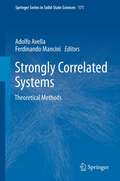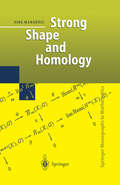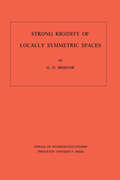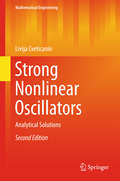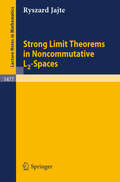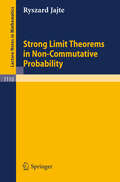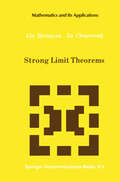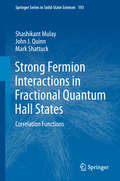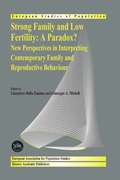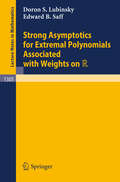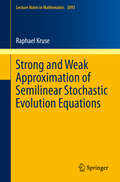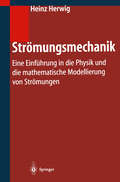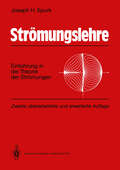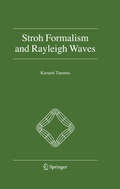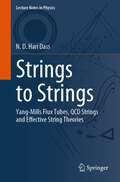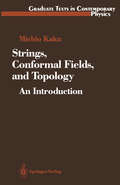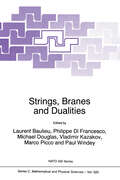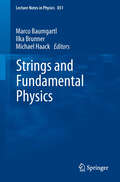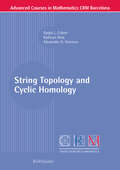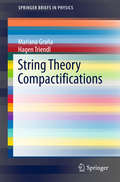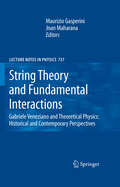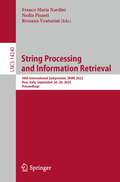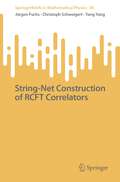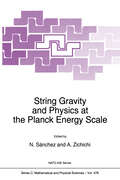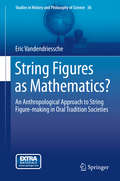- Table View
- List View
Strongly Correlated Systems: Theoretical Methods (Springer Series in Solid-State Sciences #171)
by Adolfo Avella Ferdinando ManciniThe volume presents, for the very first time, an exhaustive collection of those modern theoretical methods specifically tailored for the analysis of Strongly Correlated Systems. Many novel materials, with functional properties emerging from macroscopic quantum behaviors at the frontier of modern research in physics, chemistry and materials science, belong to this class of systems. Any technique is presented in great detail by its own inventor or by one of the world-wide recognized main contributors. The exposition has a clear pedagogical cut and fully reports on the most relevant case study where the specific technique showed to be very successful in describing and enlightening the puzzling physics of a particular strongly correlated system. The book is intended for advanced graduate students and post-docs in the field as textbook and/or main reference, but also for other researchers in the field who appreciates consulting a single, but comprehensive, source or wishes to get acquainted, in a as painless as possible way, with the working details of a specific technique.
Strong Shape and Homology (Springer Monographs in Mathematics)
by Sibe MardesicShape theory, an extension of homotopy theory from the realm of CW-complexes to arbitrary spaces, was introduced by Borsuk 30 years ago and Mardesic contributed greatly to it. One expert says: "If we need a book in the field, this is it! It is thorough, careful and complete."
Strong Rigidity of Locally Symmetric Spaces. (AM-78), Volume 78
by G. Daniel MostowLocally symmetric spaces are generalizations of spaces of constant curvature. In this book the author presents the proof of a remarkable phenomenon, which he calls "strong rigidity": this is a stronger form of the deformation rigidity that has been investigated by Selberg, Calabi-Vesentini, Weil, Borel, and Raghunathan. The proof combines the theory of semi-simple Lie groups, discrete subgroups, the geometry of E. Cartan's symmetric Riemannian spaces, elements of ergodic theory, and the fundamental theorem of projective geometry as applied to Tit's geometries. In his proof the author introduces two new notions having independent interest: one is "pseudo-isometries"; the other is a notion of a quasi-conformal mapping over the division algebra K (K equals real, complex, quaternion, or Cayley numbers). The author attempts to make the account accessible to readers with diverse backgrounds, and the book contains capsule descriptions of the various theories that enter the proof.
Strong Nonlinear Oscillators: Analytical Solutions (Mathematical Engineering)
by Livija CveticaninThis textbook presents the motion of pure nonlinear oscillatory systems and various solution procedures which give the approximate solutions of the strong nonlinear oscillator equations. It presents the author’s original method for the analytical solution procedure of the pure nonlinear oscillator system. After an introduction, the physical explanation of the pure nonlinearity and of the pure nonlinear oscillator is given. The analytical solution for free and forced vibrations of the one-degree-of-freedom strong nonlinear system with constant and time variable parameters is considered. In this second edition of the book, the number of approximate solving procedures for strong nonlinear oscillators is enlarged and a variety of procedures for solving free strong nonlinear oscillators is suggested. A method for error estimation is also given which is suitable to compare the exact and approximate solutions.Besides the oscillators with one degree-of-freedom, the one and two mass oscillatory systems with two-degrees-of-freedom and continuous oscillators are considered. The chaos and chaos suppression in ideal and non-ideal mechanical systems is explained.In this second edition more attention is given to the application of the suggested methodologies and obtained results to some practical problems in physics, mechanics, electronics and biomechanics. Thus, for the oscillator with two degrees-of-freedom, a generalization of the solving procedure is performed. Based on the obtained results, vibrations of the vocal cord are analyzed. In the book the vibration of the axially purely nonlinear rod as a continuous system is investigated. The developed solving procedure and the solutions are applied to discuss the muscle vibration. Vibrations of an optomechanical system are analyzed using the oscillations of an oscillator with odd or even quadratic nonlinearities. The extension of the forced vibrations of the system is realized by introducing the Ateb periodic excitation force which is the series of a trigonometric function. The book is self-consistent and suitable for researchers and as a textbook for students and also professionals and engineers who apply these techniques to the field of nonlinear oscillations.
Strong Limit Theorems in Noncommutative L2-Spaces (Lecture Notes in Mathematics #1477)
by Ryszard JajteThe noncommutative versions of fundamental classical results on the almost sure convergence in L2-spaces are discussed: individual ergodic theorems, strong laws of large numbers, theorems on convergence of orthogonal series, of martingales of powers of contractions etc. The proofs introduce new techniques in von Neumann algebras. The reader is assumed to master the fundamentals of functional analysis and probability. The book is written mainly for mathematicians and physicists familiar with probability theory and interested in applications of operator algebras to quantum statistical mechanics.
Strong Limit Theorems in Non-Commutative Probability (Lecture Notes in Mathematics #1110)
by R. JajteStrong Fermion Interactions in Fractional Quantum Hall States: Correlation Functions (Springer Series In Solid-state Sciences Ser. #193)
by Shashikant Mulay John J. Quinn Mark ShattuckThis monograph presents an intuitive theory of trial wave functions for strongly interacting fermions in fractional quantum Hall states. The correlation functions for the proposed fermion interactions follow a novel algebraic approach that harnesses the classical theory of invariants and semi-invariants of binary forms. This approach can be viewed as a fitting and far-reaching generalization of Laughlin’s approach to trial wave functions. Aesthetically viewed, it illustrates an attractive symbiosis between the theory of invariants and the theory of correlations. Early research into numerical diagonalization computations for small numbers of electrons shows strong agreement with the constructed trial wave functions.The monograph offers researchers and students of condensed matter physics an accessible discussion of this interesting area of research.
Strong family and low fertility: New perspectives in interpreting contemporary family and reproductive behaviour (European Studies of Population #14)
by Giuseppe A. Micheli Gianpiero Dalla ZuannaNew perspectives in interpreting contemporary family and reproductive - haviour of Mediterranean Europe 1. THE NEW GEOGRAPHY OF FERTILITY AND THE FAMILY IN EUROPE The countries of southern Europe have begun to reduce conjugal fertility at a later date compared to most other nations in the west. This has been - plained by means of the category of delay: the backwardness of the pr- esses of accumulation and economic development being seen as the cause of the maintaining of the reproductive models of the past. Moreover, the inf- ence of the Catholic Church in Italy, Spain and Portugal is supposed to have delayed the processes of secularisation, rendering difficult the changes in mentality necessary for assuming modern patterns of reproductive behaviour not only for fertility, but also for the variables which are strictly linked to it, such as sexuality, contraception and abortion (Livi Bacci, 1977; Lesthaeghe and Wilson, 1986). 1. 1. The trends of very low fertility Now the panorama is very different. Since the mid-seventies, southern Europe has been washed by the tide of a lowest-low fertility (i. e. , TFR under 1. 5 for several a prolonged period, Billari et al. , 2003), which in some areas 1 has reached and maintained scarcely imaginable levels for years on end. Conversely, other areas of Europe, where fertility started to fall many d- ades earlier than in the regions of the sourth, have recovered or maintained considerably higher levels of fertility, often close to replacement level.
Strong Asymptotics for Extremal Polynomials Associated with Weights on R (Lecture Notes in Mathematics #1305)
by Doron S. Lubinsky Edward B. Saff0. The results are consequences of a strengthened form of the following assertion: Given 0 1. Auxiliary results include inequalities for weighted polynomials, and zeros of extremal polynomials. The monograph is fairly self-contained, with proofs involving elementary complex analysis, and the theory of orthogonal and extremal polynomials. It should be of interest to research workers in approximation theory and orthogonal polynomials.
Strong and Weak Approximation of Semilinear Stochastic Evolution Equations (Lecture Notes in Mathematics #2093)
by Raphael KruseIn this book we analyze the error caused by numerical schemes for the approximation of semilinear stochastic evolution equations (SEEq) in a Hilbert space-valued setting. The numerical schemes considered combine Galerkin finite element methods with Euler-type temporal approximations. Starting from a precise analysis of the spatio-temporal regularity of the mild solution to the SEEq, we derive and prove optimal error estimates of the strong error of convergence in the first part of the book.The second part deals with a new approach to the so-called weak error of convergence, which measures the distance between the law of the numerical solution and the law of the exact solution. This approach is based on Bismut’s integration by parts formula and the Malliavin calculus for infinite dimensional stochastic processes. These techniques are developed and explained in a separate chapter, before the weak convergence is proven for linear SEEq.
Strömungsmechanik: Eine Einführung in die Physik und die mathematische Modellierung von Strömungen
by Heinz HerwigProblemlösungen in der Strömungsmechanik werden immer häufiger durch den Einsatz von kommerziellen Computerprogrammen angestrebt. Dies setzt aber voraus, dass die Physik des Problems verstanden ist. Das Buch trägt zum grundlegenden physikalischen Verständnis der Zusammenhänge bei, in dem es die Physik verschiedener Strömungsformen anschaulich darstellt. Die mathematischen Grundgleichungen insbesondere die Navier-Stokes-Gleichungen und der Energiesatz werden in allgemeiner Form bereitgestellt und in ihrer mathematischen Bedeutung erläutert. Die physikalisch/mathematische Modellierung einzelner wichtiger Strömungen bzw. Strömungsformen wird anschließend konsequent aus den Grundgleichungen abgeleitet. Der Autor verfolgt dabei systematisch das Konzept der deduktiven Herleitung. Dimensionsanalytische Überlegungen spielen eine wichtige Rolle. Zahlreiche Beispiele erläutern den Stoff.
Strömungslehre: Einführung in die Theorie der Strömungen
by Joseph H. SpurkDieses Lehrbuch stellt die Strömungslehre als einheitliche Wissenschaft dar, die in allen Zweigen den gemeinsamen Prinzipien der Kontinuumsmechanik folgt. Einzeldisziplinen der Strömungslehre werden nach dem Grundgesetz "vom Allgemeinen zum Besonderen" mit den zugehörigen vereinfachenden Annahmen behandelt. Im ersten Teil werden die Grundlagen der Strömungslehre aus moderner Sicht dargestellt. Dieser Teil enthält eine strenge, aber anschauliche Einführung in die Kinematik, die kontinuumstheoretische Formulierung der Bilanzsätze, sowie ein Kapitel über Materialgleichungen Newtonscher und Nicht-Newtonscher Flüssigkeiten. Der zweite Teil des Buches behandelt systematisch die Anwendung dieser Grundlagen auf die Technische Strömungslehre in Kapiteln über Hydrostatik, Schichtenströmungen, turbulente Scherströmungen, Schmiertheorie, Stromfadentheorie, Potentialtheorie, Überschallströmungen und Grenzschichten. In der Neuauflage werden die Themen Grenzschichttheorie und Hydrodynamische Schmierung vertieft sowie die Dynamik der geraden Wirbelfäden ausführlicher behandelt. Der Stoff wird zum großen Teil über Anwendungsbeispiele aus der Ingenieurpraxis entwickelt. Im Anhang findet sich eine Einführung in die kartesische Tensorrechnung und in krummlinige Koordinatensysteme. Das Buch wurde völlig neu gestaltet und ein Großteil der Abbildungen neu, d.h. auch quantitativ richtig, gezeichnet. Das Buch wendet sich an Ingenieure und Studenten der Ingenieurwissenschaften, Physiker und anwendungsorientierte Mathematiker; es ist nicht nur zum Gebrauch neben Vorlesungen, sondern auch für das Selbststudium gedacht.
Stroh Formalism and Rayleigh Waves
by Kazumi TanumaStroh formalism is a powerful mathematical method developed for the analysis of equations of anisotropic elasticity. This exposition introduces the essence of this formalism and demonstrates its effectiveness in both static and dynamic elasticity. The book gives a succinct introduction to Stroh formalism, discusses several important topics in static elasticity, and examines Rayleigh waves, a key topic in nondestructive evaluation, seismology, and materials science.
Strings to Strings: Yang-Mills Flux Tubes, QCD Strings and Effective String Theories (Lecture Notes in Physics #1018)
by N. D. Hari DassThis book presents the essentials culminating in the effective string theory of flux tubes in meticulous technical and conceptual detail. The book is divided into four parts. Part One provides historical background, while Part Two (consisting of 14 chapters) covers the passage from Heisenberg's S-matrix theory to String Theory. This includes non-perturbative LSZ formalism, dispersion relations, Regge poles, duality and dual resonance models. Part Three offers a comprehensive analysis of QCD, focusing on important concepts like asymptotic freedom and quark confinement. The section also delves into lattice gauge theories and effective descriptions of superconductivity and strong interactions. Part Four, the final two chapters, describe the lattice gauge theory determinations of Yang-Mills flux tubes in three and four dimensions and effective string theories, including their systematic constructions. These chapters provide detailed technical information to help readers, especially students, develop their expertise in these ideas. This book is ideal for graduate students, postdocs, and senior researchers looking to deepen their understanding of effective string theory and related concepts.
Strings, Conformal Fields, and Topology: An Introduction (Graduate Texts in Contemporary Physics)
by Michio KakuFollowing on the foundations laid in his earlier book "Introduction to Superstrings", Professor Kaku discusses such topics as the classification of conformal string theories, the non-polynomial closed string field theory, matrix models, and topological field theory. The presentation of the material is self-contained, and several chapters review material expounded in the earlier book. This book provides students with an understanding of the main areas of current progress in string theory, placing the reader at the forefront of current research.
Strings, Branes and Dualities (Nato Science Series C: #520)
by L. Baulieu Philippe Di Francesco Michael Douglas Vladimir Kazakov Marco Picco Paul WindeyAs recent developments have shown, supersymmetric quantum field theory and string theory are intimately related, with advances in one area often shedding light on the other. The organising ideas of most of these advances are the notion of duality and the physics of higher dimensional objects or p-branes. The topics covered in the present volume include duality in field theory, in particular in supersymmetric field theory and supergravity, and in string theory. The Seiberg-Witten theory and its recent developments are also covered in detail. A large fraction of the volume is devoted to the current state of the art in M-theory, in particular its underlying superalgebra as well as its connection with superstring and N = 2 strings. The physics of D-branes and its essential role in the beautiful computation of the black hole entropy is also carefully covered. Finally, the last two sets of lectures are devoted to the exciting matrix approach to non-perturbative string theory.
Strings and Fundamental Physics (Lecture Notes in Physics #851)
by Marco Baumgartl Ilka Brunner Michael HaackThe basic idea, simple and revolutionary at the same time, to replace the concept of a point particle with a one-dimensional string, has opened up a whole new field of research. Even today, four decades later, its multifaceted consequences are still not fully conceivable. Up to now string theory has offered a new way to view each particle: as different excitations of the same fundamental object. It has celebrated success in discovering the graviton in its spectrum, and it has naturally led scientists to posit space-times with more than four dimensions—which in turn has triggered numerous interesting developments in fields as varied as condensed matter physics and pure mathematics.This book collects pedagogical lectures by leading experts in string theory, introducing the non-specialist reader to some of the newest developments in the field. The carefully selected topics are at the cutting edge of research in string theory and include new developments in topological strings, or AdS/CFT dualities, as well as newly emerging subfields such as doubled field theory and holography in the hydrodynamic regime.The contributions to this book have been selected and arranged in such a way as to form a self-contained, graduate level textbook.
String Topology and Cyclic Homology (Advanced Courses in Mathematics - CRM Barcelona)
by Ralph L. Cohen Kathryn Hess Alexander A. VoronovThis book explores string topology, Hochschild and cyclic homology, assembling material from a wide scattering of scholarly sources in a single practical volume. The first part offers a thorough and elegant exposition of various approaches to string topology and the Chas-Sullivan loop product. The second gives a complete and clear construction of an algebraic model for computing topological cyclic homology.
String Theory Compactifications (SpringerBriefs in Physics)
by Mariana Graña Hagen TriendlThe lectures in this book provide graduate students and non-specialist researchers with a concise introduction to the concepts and formalism required to reduce the ten-dimensional string theories to the observable four-dimensional space-time - a procedure called string compactification. The text starts with a very brief introduction to string theory, first working out its massless spectrum and showing how the condition on the number of dimensions arises. It then dwells on the different possible internal manifolds, from the simplest to the most relevant phenomenologically, thereby showing that the most elegant description is through an extension of ordinary Riemannian geometry termed generalized geometry, which was first introduced by Hitchin. Last but not least, the authors review open problems in string phenomenology, such as the embedding of the Standard Model and obtaining de Sitter solutions.
String Theory and Fundamental Interactions: Gabriele Veneziano and Theoretical Physics: Historical and Contemporary Perspectives (Lecture Notes in Physics #737)
by Maurizio Gasperini Jnan MaharanaThis book has been prepared to celebrate the 65th birthday of Gabriele Veneziano and his retirement from CERN in September 2007. This reti- ment certainly will not mark the end of his extraordinary scienti?c career (in particular, he will remain on the permanent sta? of the Coll` ege de France in Paris), but we believe that this important step deserves a special celebration, and an appropriate recognition of his monumental contribution to physics. Our initial idea of preparing a volume of Selected papers of Professor Gabriele Veneziano, possibly with some added commentary, was dismissed when we realized that this format of book, very popular in former times, has become redundant today because of the full “digitalization” of all important physical journals, and their availability online in the electronic archives. We have thus preferred an alternative (and unconventional, but probably more e?ective) form of celebrating Gabriele’s birthday: a collection of new papers written by his main collaborators and friends on the various aspects of th- retical physics that have been the object of his research work, during his long and fruitful career.
String Processing and Information Retrieval: 30th International Symposium, SPIRE 2023, Pisa, Italy, September 26–28, 2023, Proceedings (Lecture Notes in Computer Science #14240)
by Franco Maria Nardini Nadia Pisanti Rossano VenturiniThis volume LNCS 14240 constitutes the refereed proceedings of the 30th International Symposium on String Processing and Information Retrieval, SPIRE 2023, held in Pisa, Italy, during September 26–28, 2023. The 31 full papers presented were carefully reviewed and selected from 47 submissions. They cover topics such as: data structures; algorithms; constrained Substring complexity; data compression codes; succinct k-spectra; and LCP array of wheeler DFAs.
String-Net Construction of RCFT Correlators (SpringerBriefs in Mathematical Physics #45)
by Jürgen Fuchs Christoph Schweigert Yang YangThis book studies using string-net models to accomplish a direct, purely two-dimensional, approach to correlators of two-dimensional rational conformal field theories. The authors obtain concise geometric expressions for the objects describing bulk and boundary fields in terms of idempotents in the cylinder category of the underlying modular fusion category, comprising more general classes of fields than is standard in the literature. Combining these idempotents with Frobenius graphs on the world sheet yields string nets that form a consistent system of correlators, i.e. a system of invariants under appropriate mapping class groups that are compatible with factorization. The authors extract operator products of field objects from specific correlators; the resulting operator products are natural algebraic expressions that make sense beyond semisimplicity. They also derive an Eckmann-Hilton relation internal to a braided category, thereby demonstrating the utility of string nets for understanding algebra in braided tensor categories. Finally, they introduce the notion of a universal correlator. This systematizes the treatment of situations in which different world sheets have the same correlator and allows for the definition of a more comprehensive mapping class group.
String Gravity and Physics at the Planck Energy Scale (Nato Science Series C: #476)
by Norma G. Sànchez Antonino ZichichiThe contemporary trends in the quantum unification of all interactions including gravity motivate this Course. The main goal and impact of modern string theory is to provide a consistent quantum theory of gravity. This, Course is intended to provide an updated understanding of the last developments and current problems of string theory in connection with gravity and the physics at the Planck energy scale. It is also the aim of this Course to discuss fundamental problems of quantum gravity in the present-day context irrespective of strings or any other models. Emphasis is given to the mutual impact of string theory, gravity and cosmology, within a deep a well defined programme, which provides, in addition, a careful interdisciplinarity. Since the most relevant new physics provided by strings concerns the quantization of gravity, we must, at least, understand string quantization in curved space-times to start. Curved space-times, besides their evident relevance m classical gravitation, are also important at energies of the order of the Planck scale. At the Planck energy, gravitational interactions are at least as important as the rest and can not be neglected anymore. Special care is taken here to provide the grounds of the different lines of research in competition (not just only one approach); this provides an excellent opportunity to learn about the real state of the discipline, and to learn it in a critical way.
String Figures as Mathematics?: An Anthropological Approach to String Figure-making in Oral Tradition Societies (Studies in History and Philosophy of Science #36)
by Eric VandendriesscheThis book addresses the mathematical rationality contained in the making of string figures. It does so by using interdisciplinary methods borrowed from anthropology, mathematics, history and philosophy of mathematics. The practice of string figure-making has long been carried out in many societies, and particularly in those of oral tradition. It consists in applying a succession of operations to a string (knotted into a loop), mostly using the fingers and sometimes the feet, the wrists or the mouth. This succession of operations is intended to generate a final figure. The book explores different modes of conceptualization of the practice of string figure-making and analyses various source material through these conceptual tools: it looks at research by mathematicians, as well as ethnographical publications, and personal fieldwork findings in the Chaco, Paraguay, and in the Trobriand Islands, Papua New Guinea, which all give evidence of the rationality that underlies this activity. It concludes that the creation of string figures may be seen as the result of intellectual processes, involving the elaboration of algorithms, and concepts such as operation, sub-procedure, iteration, and transformation.
